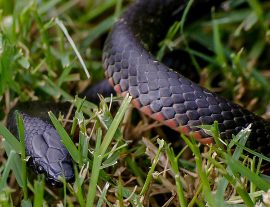Humans are not the only creatures who get out and about more during warmer months. From October to April snakes are far more active, leading to a marked increase in the number of pets being bitten.
Prevention
Snake bites can be deadly and treatment expensive. Try to avoid snake bites by:
- Walking your dog on a lead, staying on open paths, avoiding bushland, high grass and rocks, and not letting your dog explore holes, rocks and logs
- Keeping your yard tidy of junk where snakes may hide and storing firewood away from the house
- Cleaning up spilled food or bird seed that attract rodents and inturn snakes
- Not letting your pet examine dead snakes as they still have venomous fangs
- Constructing a snake-proof fence around your property
- Having snakes on your property removed by a professional.
Symptoms
Pet owners will often not witness a snake bite and locating a bite mark can be difficult. It is therefore important to be familiar with the symptoms of a bite. Although these vary depending on the type of snake, amount of venom injected and the site of the bite, general symptoms include:
- Sudden collapse
- Vomiting
- Salivation
- Lethargy
- Hind leg weakness and unsteadiness
- Lack of coordination and disorientation
- Dilated pupils
- Shaking, trembling or twitching
- Blue gums
- Loss of bladder and bowel control
- Paralysis
- Blood in urine.
See a vet immediately
If you suspect your pet has been bitten by a snake, get the animal to the nearest vet immediately, as death can occur in as little as 30 minutes. Prompt treatment can increase the chance of survival significantly.
Keep your pet as still as possible and do NOT wash the wound or apply a tourniquet.
If you saw the snake, advise the vet of the snake type or describe what it looked like. If you did not see the snake, a blood or urine test will identify the snake type. Once identified, the vet will administer anti-venom. Your pet will then be hospitalized, generally for a minimum of 24 hours, for intensive monitoring and supportive care such as intravenous fluids and pain relief.


